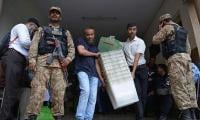Monetary policy for August-September
KARACHI: The central bank, as widely expected, kept the benchmark interest rate unchanged at 5.75 percent on Saturday, staying focused on containing rising inflation while adopting a more dovish tone in response to the government's call for help to boost economic growth.
“The Monetary Policy Committee, after detailed deliberations, has decided to maintain the policy rate at 5.75 percent (for August-September period),” Ashraf Wathra, Governor State Bank of Pakistan (SBP) told a news conference.
The bank unexpectedly cut the target policy rate to 5.75 percent from 6 percent on May 21 and the current policy rate is hovering at historically low levels. The rate has seen a cumulative reduction of 425 basis points from 10 percent in October 2014. The central bank slashed its key policy rate by 75 basis points in the last fiscal year of 2015/16.
Wathra said an increased economic activity may impact the central bank’s average consumer price index inflation forecast of 4.5-5.5 percent for the current fiscal year. “Any upward adjustments in gas tariff, fiscal slippages, and supply disruptions pose risk to this assessment. Uncertain global oil price is the major risk to this projection,” he added. “In addition to the sluggish global demand, possible dampening impact of Brexit on global commodity prices and difficulties in clearing excess domestic food stock also poses risk to this inflation forecast.”
Annual inflation hit a 13-year low of 2.86 percent during the last fiscal year of 2015/16. However, in June, the consumer inflation inched up to 3.2 percent year-on-year.
Wathra said the economy was expanding, but it can face a number of headwinds, including higher trade deficits, sluggish global trade and slowdown in workers’ remittances.
Unexpected increase in oil prices may result in wider trade deficit. Further deterioration in global trade due to slowdown in China may accentuate this problem,” the governor said. “Slowdown in Gulf region may decelerate growth in workers’ remittances. Furthermore, uncertainties about recovery in the EU in the post Brexit period can have repercussions for financial inflows and trade to the country.”
Exports dipped 12.11 percent in the fiscal year ended June 30, while imports dropped 2.32 percent, leaving the country with a trade deficit of $23.963 billion.
Wathra said exports, last fiscal, declined in value on soft global commodity prices.
“I ‘m pretty confident that the stimulus being provided by the government and the central bank such as a zero-rated tax regime for five export oriented sectors and low refinancing rates…. will boost exports during the current fiscal.”
Wathra said factors affecting the outlook for external sector in the current fiscal year are broadly similar to that of the last fiscal
“Even with a slight increase in current account deficit, on account of expected higher non-oil imports, positive growth in workers’ remittances are likely to keep it at manageable levels,” he said. “At the same time, substantial bilateral and multilateral project loans related flows in the financial account will help maintain an overall surplus in the balance of payments.” The central bank governor said the country’s economic growth is set to increase further in the current fiscal year. But he also cautioned that an adverse supply shocks, continued declining trend in commodity prices, and any setback to security situation may hamper the possibility of attaining the growth target of 5.7 percent in the current fiscal year.
“The impetus is likely to come from the continuation of same positive factors … including rising investment under PSDP and CPEC; improved energy availability to industry; lagged impact of prudent monetary policy; healthy private sector credit uptake; and improving law and order situation,” he added.
Wathra said two intertwined factors are central in shaping up a possible high growth scenario.
“First, investments and activities related to PSDP and CPEC are going to gain full traction which will be crucial in giving further boost to construction and allied industries, large scale manufacturing, electricity generation and its impact on services sector, and promoting an investment climate in the country,” he said. “Second, a successful end to the IMF program will bring the much-needed confidence boost to Pakistan economy and the government which can further enhance the growth prospects in FY17.” The governor said the country would not seek another IMF loan after completion of the current $64 billion extended loan facility programme.
“We would say goodbye to the IMF once the extended fund facility programme gets finished in September,” Wathra said. “But, the reviews and monitoring of the economy will be going on by the Fund.”
This picture released on August 13, 2023, shows WAPDA House in Lahore. — Facebook/WAPDALAHORE: Water and Power...
This image released on April 18, 2024, shows the meeting on Kisan Card at the Sindh Secretariat. — Facebook/Jam...
Pakistan State Oil HQs can be seen in this picture. — PSO websiteKARACHI: Pakistan State Oil and Pakistan Railways ...
This representational image shows gold bars. — UnsplashKARACHI: Gold prices increased by Rs500 per tola on Friday in...
Representational image of a working oil pumpjack. — AFP/FileLONDON: Plentiful supplies of some of the biggest crude...
Prime Minister personally promises to ensure that our bureaucracy does not play tricks with them







